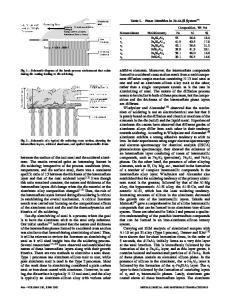The surface tension of molten aluminum and Al-Si-Mg alloy under vacuum and hydrogen atmospheres
- PDF / 632,275 Bytes
- 6 Pages / 612 x 792 pts (letter) Page_size
- 45 Downloads / 259 Views
I. INTRODUCTION
ACCURATE information on the surface tension of aluminum and its alloys is necessary for many metallurgical and materials-related processes, such as casting, welding, brazing, sintering, and the fabrication of metal-matrix composites.[1,2] Small bubbles, known as microporosity, are a common defect found in aluminum castings. These pores arise primarily from the evolution of hydrogen gas during solidification due to a marked decrease in the solubility of hydrogen in liquid and solid aluminum.[3] Four forces act on a gas bubble that is present in a liquid metal. The internal gas pressure (Pg) acts to increase the bubble size, while the liquid head or metallostatic pressure (Pm), the atmospheric pressure (Pa), and the surface tension forces (Pst) tend to make the bubble shrink. Obviously, at equilibrium, the following relationship must hold:[4] Pg 5 Pm 1 Pa 1 Pst
[1]
In the majority of casting processes, the metallostatic pressure is quite small in comparison to the other pressures so that Pg ' Pa 1 Pst
[2]
The surface-tension pressure is determined by the surface tension of the liquid metal (s) and the bubble radius. For a nonspherical bubble, Pst 5 s(1/r1 1 1/r2)
[3]
where r1 and r2 are the principle radii of curvature. If the bubble is spherical, this expression becomes Pst 5 2s/r
[4]
There is considerable current interest in the development of mathematical models to describe microporosity formation in cast parts.[4–8] Realistic models require that the surface tension of the liquid alloy be known. The majority of the experimental measurements of the
J.P. ANSON, Postdoctoral Student, Department of Metallurgy Engineering, R.A.L. DREW, Professor and Chair, Department of Mining and Metallurgical Engineering, and J.E. GRUZLESKI, Professor and Dean, Faculty of Engineering, are with McGill University, Montreal, PQ, Canada H3A 2B2. Manuscript submitted November 18, 1998. METALLURGICAL AND MATERIALS TRANSACTIONS B
surface tension of aluminum and its alloys have been carried out under vacuum or inert gas, typically argon, and do not necessarily represent the conditions that prevail when microporosity forms in a solidifying casting. This is particularly true for aluminum alloys where the gas contained in the pore is hydrogen, and certain alloying elements form metal hydrides[9] (Table I). As a general rule, surface contaminants, such as the hydrides, reduce the surface tension of the metal. It is possible that such hydrogen-metal interactions may be responsible for increased amounts of porosity found with the addition of small amounts of certain alloying elements. This holds particularly true for strontium, which is added to the alloy to modify the silicon structure. Strontium forms a stable hydride at temperatures up to 1000 K and is known to cause an increase in porosity[10,11] in cast aluminum alloys. The present article reports on measurements of the surface tension of a nonmodified and strontium modified aluminum casting alloy (A356) under vacuum and hydrogen gas atmosphere. One of the main obje
Data Loading...









